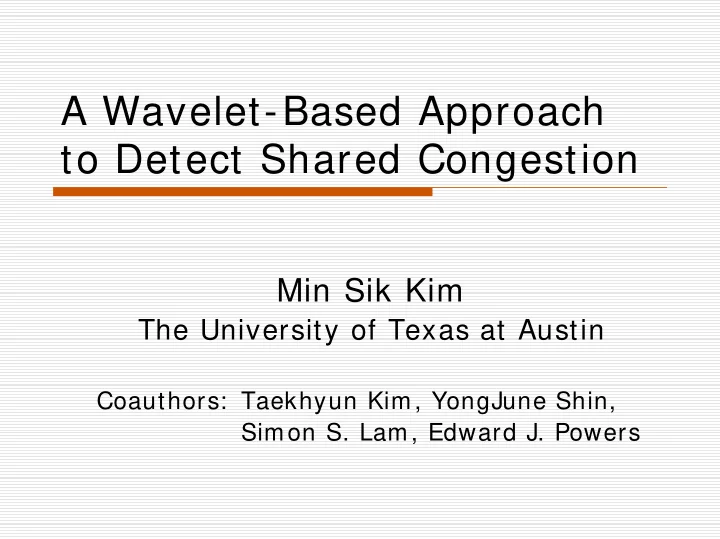

A Wavelet-Based Approach to Detect Shared Congestion Min Sik Kim The University of Texas at Austin Coauthors: Taekhyun Kim, YongJune Shin, Simon S. Lam, Edward J. Powers
Cooperative Congestion Control � Better utilization of network resources � Applications � Congestion Manager, path diversity � Improving overlay network topology � end system multicast, overlay routing, ... � Identify flows sharing a bottleneck!
Previous Approaches to Detect Shared Congestion � Loss-based techniques � Work with lossy links, drop-tail queues � Do not work with low loss rate, RED � Delay-based techniques � More robust than loss-based ones � Limitation � Require a common endpoint
Outline � Introduction � Basic technique � Limitations of the basic technique � DCW: Delay Correlation with Wavelet denoising � Experimental results � Summary
Model � Observations on queueing delay � Congested link: large fluctuations � Non-congested link: stable
Basic Technique
1 = XY Shared Congestion XCOR Queueing delay vs. time
0 Independent Congestion ≈ XY XCOR
1 st Limitation of Basic Technique Queueing Delay Variation
2 nd Limitation of Basic Technique Synchronization Offset
Outline � Introduction � Basic technique � Limitations of the basic technique � DCW: Delay correlation with Wavelet denoising � Experimental results � Summary
Queueing Delay Characteristics 12 Queueing Delay 60 0 0 50 Time (sec) 0 0 50 Time (sec) � Heavy traffic: 2% –10% loss � Light traffic: no loss
Wavelet Transform x ( t ) Measured data Time Wavelet basis X 0 L 0 O Scale i M X Wavelet coefficient at j scale i and translation j O Translation
Wavelet Denoising ⎧ − ≥ � Soft thresholding X T if X T ⎪ = + ≤ � ⎨ Threshold: T d T ( X ) X T if X T ⎪ < 0 if X T ⎩ Wavelet Denoising Wavelet Denoising
Minimizing Sync Offset Effects � Error introduced by sync offset � f ( t ): original data � f ( t - Δ ): shifted data due to sync offset � f ( t )- f ( t - Δ ): error � To minimize effects of sync offset: � f ( t ) and ψ should match closely � f ( t )- f ( t - Δ ) and ψ should not
Match Between Data Signal and Wavelet Basis � Elliptic curve representation on time- frequency plane Frequency (Hz) � C, D 1 : Data Signal � C, D 2 : Wavelet basis T Time duration (sec) � ISNR: similarity of elliptic curves 1 C = ISNR 10 log + 10 T D D 1 2
Wavelet Basis Selection � Differential ISNR � (ISNR between f ( t ) and ψ ) – (ISNR between f ( t )- f ( t - Δ ) and ψ ) � Daubechies wavelets .3 Differential ISNR � Simple � Easy to implement Daubechies Wavelet 6 0 2 10 Wavelet Index
Evaluation � Comparison with � MP: delay-based [ Rubenstein, et al] � BP: loss-based [ Harfoush, et al] � Positive Ratio # of answers indicating shared congestion # of experiments � 1: shared congestion � 0: no shared congestion
Common Source Topology � X src and Y src are synchronized � No synchronization offset
Common Source / Drop-Tail / Long-Lived TCP Traffic 1 DCW shared MP shared Positive Ratio BP shared DCW independent MP independent BP independent 0 1 10 100 0.1 Time (sec) f f � Shared: DCW MP BP f � Independent: MP DCW ≈ BP
Common Source / Drop-Tail / On-Off CBR Traffic 1 DCW shared MP shared Positive Ratio BP shared DCW independent MP independent BP independent cf. Long-lived TCP 0 1 10 100 0.1 Time (sec) � Slower convergence due to Delay on non-congested links → DCW, MP � Shorter loss runs → BP �
Common Source / Drop-Tail / Short-Lived TCP Traffic 1 DCW shared MP shared Positive Ratio BP shared DCW independent MP independent BP independent 0 1 10 100 0.1 Time (sec) � Even shorter loss runs → BP fails.
Common Source / RED Long-lived TCP On-Off CBR Short-lived TCP 1 Positive Ratio 0 0.1 1 10 100 1 10 100 1 10 100 Time (sec) Time (sec) Time (sec) � DCW and MP: DCW shared MP shared BP shared similar as with drop-tail DCW independent MP independent � BP fails BP independent
Topology without Sync Point � Synchronization offset > 0
Sync Offset Tolerance Long-lived TCP Positive Ratio 1 DCW MP 0 .01 .1 1 10 On-Off CBR Short-lived TCP Positive Ratio 1 1 0 0 .01 .1 1 10 .01 .1 1 10 Sync offset (sec) Sync offset (sec) � DCW: 1–2 sec, MP: 30–70ms, BP: < 10ms
Internet Experiment � Topology 1 Shared Positive Ratio Non-shared � 10 seconds 0 .1 1 10 to converge Time (sec)
Summary � Proposed technique: DCW � Delay Correlation with Wavelet denoising � As fast and accurate as previous techniques (with a common endpoint) � Applicable to any 2 Internet paths � Basic primitive for overlay topology improvement
Recommend
More recommend